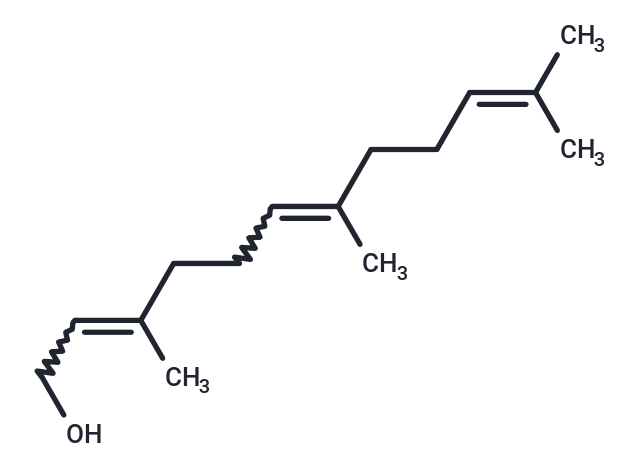Shopping Cart
Remove All Your shopping cart is currently empty
Your shopping cart is currently empty
Farnesol is a natural product, has the activity in inhibiting bacteria.

| Pack Size | Price | USA Warehouse | Global Warehouse | Quantity |
|---|---|---|---|---|
| 500 mg | $40 | - | In Stock | |
| 1 g | $48 | - | In Stock | |
| 1 mL x 10 mM (in DMSO) | $39 | - | In Stock |
| Description | Farnesol is a natural product, has the activity in inhibiting bacteria. |
| In vivo | Farnesol, an acyclic sesquiterpene alcohol, is predominantly found in essential oils of various plants in nature,?exhibit anti-cancer and anti-inflammatory effects, and also alleviate allergic asthma, gliosis, and edema.?In numerous tumor cell lines, farnesol can modulate various tumorigenic proteins and/or modulates diverse signal transduction cascades.?It can also induce apoptosis and downregulate cell proliferation, angiogenesis, and cell survival.?To exert its anti-inflammatory/anti-oncogenic effects, farnesol can modulate Ras protein and nuclear factor kappa-light-chain-enhancer of activated B cells activation to downregulate the expression of various inflammatory mediators such as cyclooxygenase-2, inducible nitric oxide synthase, tumor necrosis factor alpha, and interleukin-6[1]. |
| Molecular Weight | 222.37 |
| Formula | C15H26O |
| Cas No. | 4602-84-0 |
| Smiles | CC(C)=CCCC(C)=CCCC(C)=CCO |
| Relative Density. | 0.886 |
| Storage | keep away from direct sunlight,keep away from moisture | Powder: -20°C for 3 years | In solvent: -80°C for 1 year | Shipping with blue ice/Shipping at ambient temperature. | |||||||||||||||||||||||||
| Solubility Information | DMSO: 9 mg/mL (40.47 mM), Sonication is recommended. | |||||||||||||||||||||||||
| In Vivo Formulation | 10% DMSO+40% PEG300+5% Tween 80+45% Saline: 1 mg/mL (4.5 mM), Sonication is recommended. Please add the solvents sequentially, clarifying the solution as much as possible before adding the next one. Dissolve by heating and/or sonication if necessary. Working solution is recommended to be prepared and used immediately. The formulation provided above is for reference purposes only. In vivo formulations may vary and should be modified based on specific experimental conditions. | |||||||||||||||||||||||||
Solution Preparation Table | ||||||||||||||||||||||||||
DMSO
| ||||||||||||||||||||||||||
| Size | Quantity | Unit Price | Amount | Operation |
|---|

Copyright © 2015-2025 TargetMol Chemicals Inc. All Rights Reserved.